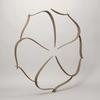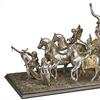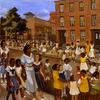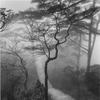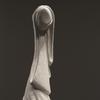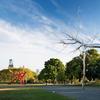Block Museum's ‘If You Remember, I’ll Remember’ poses timely questions
- EVANSTON, Illinois
- /
- April 13, 2017
Contemporary group art exhibition explores purposes and processes of remembering
• Explores themes of mourning, civil rights, internment, war and love
• Engages with 75th anniversary of Japanese-American Internment and 50th anniversary of the Supreme Court’s Loving v. Virginia case
• Ongoing through June 18, exhibition is a site for collective conversation, meeting and remembrance
“If You Remember, I’ll Remember,” a current exhibit at the Mary and Leigh Block Museum of Art at Northwestern University, explores themes of love, mourning, war, relocation, internment, resistance and civil rights in 19th - and 20th - century America.
Featuring work by seven contemporary American artists, the timely exhibition serves as an invitation to reflect on the past while contemplating the present, invoking dialogue about the nation’s history. Exploring the complexity and materiality of memory, the exhibition asks: What are the responsibilities of those who remember? What objects and processes are key to our remembrances?
Organized by Janet Dees, the Block Museum’s curator of global modern and contemporary art, the exhibition includes works by artists Kristine Aono (b. 1960), Shan Goshorn (b. 1957), Samantha Hill (b. 1974), McCallum & Tarry (active 1998 to 2013), Dario Robleto (b. 1972) and Marie Watt (b. 1967). The exhibition will be on view Feb. 4 to June 18 at the Block Museum, 40 Arts Circle Drive on the Evanston campus.
The artists in “If You Remember, I’ll Remember” pose questions about the purposes and processes of remembering by engaging with historic documents, photographs, sound recordings, oral histories and objects of material culture drawn from institutional and informal archives. The exhibition title is taken from a 2013 essay by artist Dario Robleto.
“We are thrilled to present this resonant and timely show, which is the first in-house exhibition originated by curator Janet Dees,” noted Lisa Corrin, the Block Museum Ellen Philips Katz Director. “The Block is dedicated to serving as a springboard for thought-provoking discussions relevant to our lives today. ‘If You Remember, I’ll Remember’ exemplifies our goals to bring diverse stories to the fore, to expand engagement with the archive and to host rich conversations between campus and community.”
Historical Touchstones
This year marks two milestones that connect to works in the exhibition. Feb. 9 was the 75th anniversary of Executive Order 9066, which ordered the war-time internment of more than 120,000 Japanese-American citizens and residents living on the west coast of the United States.
June 12 is the 50th anniversary of the Supreme Court’s decision in the case of Loving v. Virginia, which found laws prohibiting interracial marriage (then in effect in 16 states) unconstitutional.
Touchstones for other works include a class photograph of students at Pennsylvania’s Carlisle Indian Industrial School (operational 1879 to 1918), documents from a Chicago family archive relating to the early history of the 16th Street Baptist Church in Birmingham, Alabama, a photograph of an early 20th century potlatch off Vancouver Island and the love letters of soldiers who served in various wars in which the United States was involved.
“The terrain explored by the works in this exhibition is diverse, juxtaposing issues that aren’t often considered in relationship to each other,” Dees said. “These artists each employ poetic strategies, drawing inspiration from artifacts that serve as touchstones of memory.”
Timely Themes
“If You Remember, I’ll Remember” incorporates the work of seven contemporary American artists. A third generation Japanese-American and Chicago native Kristine Aono’s work is often influenced by the history of her family and her interest in questioning narratives of race, acculturation and cultural identity. The artist’s 48-foot-long participatory installation, “The Nail That Sticks Up the Farthest ...” (2017), memorializes and draws attention to the internment during World War II of 120,313 Japanese-American residents, two-thirds of whom were U.S. born American citizens.
The installation incorporates testimonies of former internees given during the 1981 to 1983 Commission on Wartime Relocation and Internment of Civilians as well as a letter written by the artist’s grandfather, who had been interned at the camp in Minidoka, Idaho.
Eastern Cherokee artist and activist Shan Goshorn turned to basket weaving as her main mode of expression in 2008 after many years of working primarily as a painter and photographer. Her technically intricate objects are made of reproductions of historic photographs and transcriptions of historic documents and other texts. Goshorn’s conceptual baskets combine Cherokee aesthetics with thought-provoking content, including historical photographs and texts, to address the linkage between historical events and ongoing struggles for Native American sovereignty and self-determination. Several of her works are included in the exhibition. Her sources range from a photograph from the National Anthropological Archives (Smithsonian Institution) of students at the Carlisle Indian Industrial Boarding School to the text of the 1835 Treaty of New Echota between the United States and the Cherokee Nation.
Since 2009, Chicago artist Samantha Hill has been developing the Kinship Project Archive, a repository comprised of oral histories and more than 3,000 objects, including vintage photographs and scrapbooks mostly from African-American families. The items are obtained primarily through Hill’s in-depth engagement with various U.S. communities, particularly in Anchorage, Alaska, Charlotte, North Carolina, and Chicago. Her installation “Herbarium”(2015 to 2017) was first presented at the Hyde Park Art Center in 2015 and has been revised and expanded for this exhibition.
The work was inspired by a gift of artifacts from a Hyde Park family dating from 1839 to 1940 and includes newspaper clippings, letters and other documents related to family history and political events in the South. Hill’s work also features items related to the early of history of Birmingham’s 16th Street Baptist Church, which became a nationally charged site in 1963 when members of the Ku Klux Klan bombed the building, killing four little girls.
McCallum & Tarry’s “Exchange” (2007)is one of several self-portrait video works the artists produced between 2004 and 2010 in which they explore their relationship to each other in conversation with larger historical and social factors. The video features the artists, who were married at the time, engaged in a mutual blood transfusion. The exchange of blood can represent the solidification of an intimate bond or an oath of loyalty. Here it specifically references the “one-drop rule” and the complex history of laws and customs governing race and interracial relationships in the United States. The soundtrack for “Exchange” combines excerpts from archival recordings dating from 1941 to 1965 relating to the struggles for civil rights in the South, including field recordings of officers’ boots striking the pavement during the March 7, 1965, “Bloody Sunday” march in Selma, Alabama.
Dario Robleto is represented by a selection of works from his “War Series” (2001- 2010). Initiated during the aftermath of the Sept. 11 attacks, the works are a meditation on the intimate and personal dimensions of loss experienced as a result of war. Robleto’s poetic sculptures reform and repurpose historic material cultural items, emphasizing the work of remembering and the bonds of love that work implies. By drawing elements from the Civil War to the recent conflicts in Iraq and Afghanistan, Robleto’s works speak to the conditions of love and loss, rather than commenting on any one war in particular.
Marie Watt’s work is concerned with the potential of everyday objects to spark memory and inspire narrative, and her practice is heavily influenced by indigenous, particularly Seneca, principles, biography, oral tradition and history. The wide-ranging functions and associations of blankets, including their use as gifts to those who witnessed important events in Seneca culture, have made them a potent material for the artist.
“Witness”(2015)was inspiredby a photograph of a 1913 Quamichan potlatch near Vancouver Island that the artist encountered in the Royal British Columbia Museum and Archives. Watt reinterpreted the image at cinematic scale by embroidering it onto a vintage double-length trade blanket and inserting a portrait of herself and her daughters in the right foreground as contemporary witnesses to this historical event. She was struck by the fact that the potlatch could be interpreted as an act of civil disobedience, as these ceremonial gatherings were banned by the Canadian and American governments from the 1880s to the 1950s.
Collaborative Creation
The Block Museum has commissioned Watt to create a new work that will stem in part from her engagement with the Block community. This project will be developed during the run of the “If You Remember, I’ll Remember” exhibition and installed in April 2017. During the exhibition, Watt will work with Northwestern’s Native American and Indigenous Peoples Steering Group, Native American Indigenous Studies Association, Colloquium on Indigeneity and Native American Studies, Multicultural Student Affairs and the Office of Neighborhood and Community Relations to host making events that weave conversation and connections as well as textiles.


